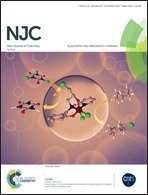Cooperative vibrational properties of hydrogen bonds in Watson–Crick DNA base pairs†
Abstract
A detailed analysis of hydrogen bonding (H-bonding) nuclear motions is presented for adenine–thymine (AT) and guanine–cytosine (GC) Watson–Crick DNA base pairs. Using first-principles calculations, we investigated the infrared (IR) spectroscopy and nuclear vibrating patterns of multiple H-bond interactions, compared with those of the individual H-bonding base pairs. For the first time, we have shown that multiple H-bonds arouse collective nuclei vibrations, and retain “intensifying” and “bounding” effects on symmetric and asymmetric donor stretching, respectively. This gives the H-bonds an unexpectedly amplified effect. On the other hand, H-bonds that donate charge in different directions reinforce each other through enhanced orbital interactions, indicating a correlated fashion of electronic activities. The coordinated nuclei motion and electron transport constitutes a simple form of H-bond cooperation. This study brings a new perspective of H-bond cooperativity and should enhance our knowledge of the control of H-bonds. Due to their important universality, such properties can benefit experimental applications in spectroscopy, material designing, and biological processes for complex H-bonding systems.



 Please wait while we load your content...
Please wait while we load your content...